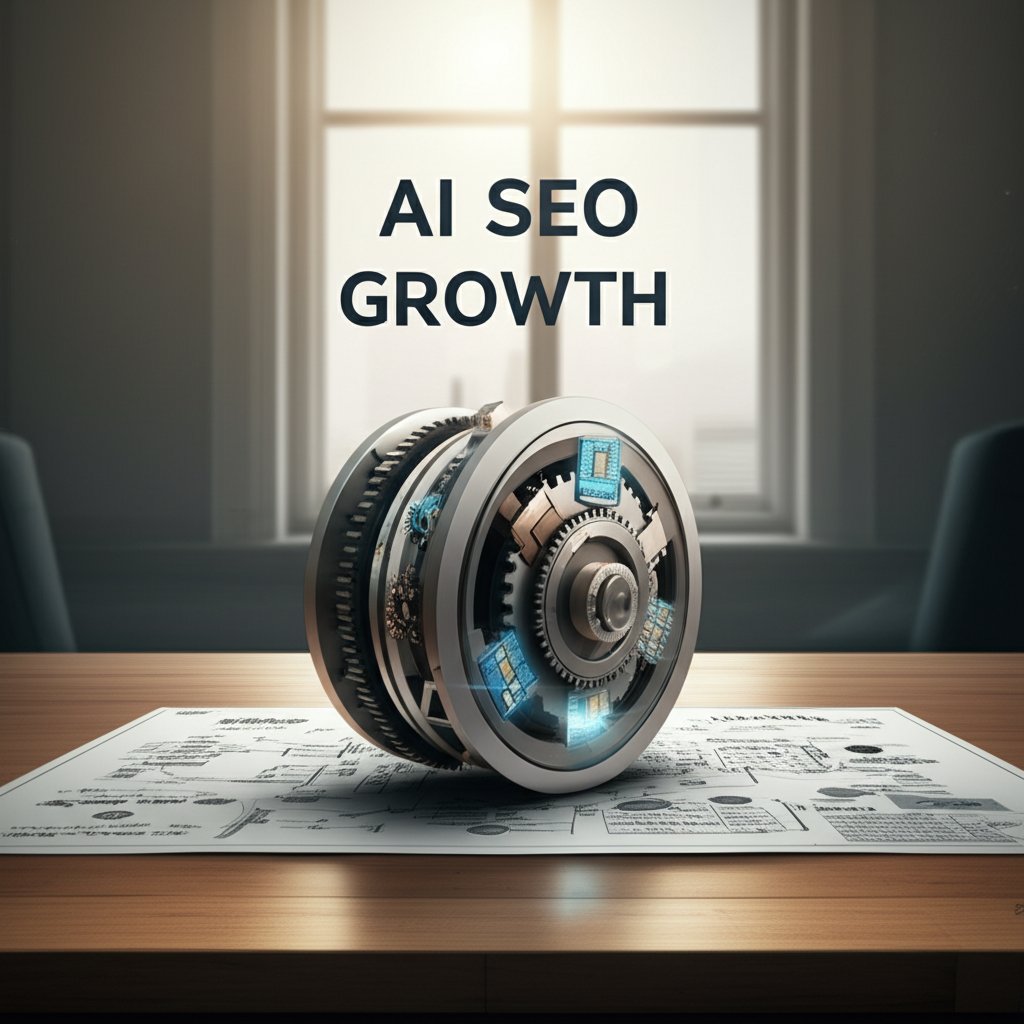AI vs. Manual: Master Your Content Flywheel for Growth

The realm of digital marketing is experiencing a profound overhaul. Enterprises are increasingly realizing that maintaining robust online presence necessitates a departure from traditional, labor-intensive content production methods towards a more efficient, automated methodology. The classic image of a content crew ceaselessly churning out articles as if on a treadmill—investing monumental effort for minimal returns—is swiftly becoming a relic of the past. Instead, astute organizations are implementing an automated content flywheel, where every piece of material naturally propels the next, forging a self-sustaining engine for expansion.
Industry reports highlight that a significant number of businesses struggle to uphold consistent content volume, with over 70% attributing this to time and resource constraints. This inability to scale frequently leads to missed opportunities in search engine visibility and audience engagement. The strategic imperative is unequivocal: embrace intelligent automation to construct a content mechanism that not only keeps pace but actually accelerates market leadership.
The Content Treadmill: Manual Efforts' Roadblocks

For an extended period, content strategy was synonymous with a relentless manual grind. Teams dedicate countless hours to keyword research, drafting, editing, and publishing, only to perpetually find themselves playing catch-up. This conventional model, while foundational, is inherently limited in its capacity for growth and often induces content fatigue, both for creators and, eventually, for the readership.
Online insights reveal a growing skepticism directed at generic, purely informational content. As one observer aptly put it, the sheer volume of easily generated data has resulted in a state of "informational numbness." Readers are becoming adept at discerning content that lacks genuine insight, a distinct viewpoint, or a human touch. This implies that merely producing more content is inadequate; it must be high-quality, pertinent, and captivating to cut through the din. The manual treadmill, built for volume, frequently falls short on originality and impact.
Key Takeaway: Content generated through manual efforts, though foundational, struggles with scaling and often yields uninspired outputs in an oversaturated information landscape.
Embracing the Automated Flywheel: AI as a Propeller of Growth

An automated content flywheel fundamentally redefines the entire content production paradigm. Rather than a linear, end-to-end process for each individual piece, artificial intelligence transforms content into a continuous, self-optimizing cycle. This strategy harnesses AI to analyze audience demands, pinpoint strategic keywords, generate preliminary drafts, and even orchestrate distribution, effectively converting content into a potent inbound marketing powerhouse.
Consider the substantial benefit of real-time predictive analytics. Online discussions underscore the transformative potential for businesses to precisely identify when their audience is most active or what specific content formats they desire. This eradicates guesswork, ensuring resources are concentrated on endeavors that will directly drive conversions. With personalized approaches, targeting becomes incredibly precise, leading to substantially enhanced marketing outcomes. Platforms like OutBlogs, for instance, are engineered to orchestrate this entire workflow, from automated authority building and SEO optimization to effortless dissemination, empowering businesses to transform their websites into continuous traffic magnets without the typical manual burden. This guarantees content is not merely created, but strategically deployed for maximum impact and consistent organic expansion.
Key Takeaway: An AI-powered automated flywheel facilitates strategic content creation, predictive analysis, and efficient distribution, forging a self-perpetuating growth mechanism.
The Human Element: Crafting Authentic AI-Augmented Content
The emergence of AI in content creation has sparked legitimate concerns regarding originality and authenticity. As various online conversations indicate, many brands worry their unique voice might become diluted if AI handles everything without human oversight. The true challenge lies not in avoiding AI, but in mastering the collaborative dance between human ingenuity and artificial intelligence to produce content that genuinely resonates and distinguishes itself.
The objective is to ensure that even with AI assistance, content preserves a distinctive brand identity and delivers genuine value. This entails leveraging AI for its inherent strengths—speed, data processing, and initial draft generation—while reserving human expertise for strategic direction, unique perspectives, storytelling, and ethical considerations. Transparency in AI deployment, particularly within B2B contexts, is also becoming increasingly crucial.
Here’s how to guarantee high-quality, authentic AI-augmented content:
- Define and Instill Brand Voice: Before AI takes the reins, clearly articulate your brand's singular tone, core values, and messaging. Provide the AI with ample examples of your existing, high-performing content as a learning reservoir. Always have a human editor review and refine AI-generated drafts to ensure perfect alignment with your brand's personality and to inject specific narratives or viewpoints that AI cannot replicate.
- Focus on Novel Insights and Narrative: While AI excels at information synthesis, it cannot replicate lived experiences or truly groundbreaking ideas. Utilize AI for research and outlining, but task human writers with incorporating unique anecdotes, real-world case studies, personal accounts from team members, and behind-the-scenes glimpses that showcase internal proficiency. This is where authentic differentiation happens.
- Prioritize Depth Over Pace: The core advantage of AI is speed, but speed alone isn't sufficient. Leverage the time saved by AI to enrich the content. Integrate more relevant data points, explore a broader spectrum of viewpoints, and provide more compelling narratives. Rapid content isn't the issue; shallow content is. The aim is to deliver enhanced value with speed.
- Strategic Distribution and Engagement: Do not solely rely on organic SEO. Distribute AI-generated content across a variety of channels. Actively syndicate material to specialized communities, develop newsletters featuring curated perspectives, and interact directly with users in forums or at events. This diversified approach ensures content reaches its intended audience and cultivates genuine engagement, which human interaction often facilitates.
Key Takeaway: Effective AI integration means capitalizing on its speed for efficiency while prioritizing human supervision to infuse unique brand voice, original insights, and authentic storytelling.
Scaling Authority: A Blueprint for Automated Content Dominance
Consider the trajectory of GrowthForge Solutions, a rapidly expanding B2B SaaS provider specializing in enterprise resource planning. Initially, GrowthForge grappled with substantial hurdles in escalating its content output to meet its ambitious growth projections. Their manual content production framework, dependent on a small writing team, struggled to encompass the vast array of niche long-tail keywords essential for capturing market share.
Recognizing the limitations of this "treadmill" methodology, GrowthForge strategically implemented an advanced content automation platform. This solution was tasked with analyzing search trends, identifying high-potential keywords, generating comprehensive article outlines, and drafting initial content pieces across their diverse product portfolios. The internal team then dedicated their efforts to refining these drafts, imbuing them with proprietary insights, customer success narratives, and expert commentary to elevate the content's authority and distinctiveness.
The outcomes were revolutionary. Within nine months of adopting this automated flywheel strategy, GrowthForge Solutions observed an impressive 60% surge in organic traffic to their blog. More critically, their qualified lead generation doubled, directly attributable to securing top 3 rankings for over 15 high-value, previously untapped keywords. This paradigm shift not only reduced their content production expenditures by an estimated 35% but also empowered their marketing team to allocate more time to strategic initiatives and direct customer interaction, rather than the perpetual cycle of content creation. The seamless fusion of AI-powered content generation with human expertise forged a potent engine for sustained market leadership.
Key Takeaway: Strategic AI deployment can dramatically amplify organic traffic and lead generation, transforming content into a scalable asset for market preeminence.
Strategic Deployment: Navigating the AI Content Terrain
The successful implementation of AI in content strategy extends beyond mere text generation; it's fundamentally about resolving tangible business challenges. As insights from entrepreneurs venturing into the AI domain reveal, the most effective AI applications concentrate on specific industries and tackle high-value problems. It's not about engineering a general-purpose AI writer, but rather a solution precisely tailored to a defined necessity.
Experts underscore that genuine success in AI-driven business models frequently stems from profound domain expertise. A deep understanding of an industry's complex issues is far more crucial than possessing cutting-edge technical AI skills. Companies are prepared to invest significantly in solutions that yield substantial operational cost savings, mitigate risks, or enhance compliance. This points to a strategic shift towards B2B applications where the return on investment for automation is clear and quantifiable, moving away from consumer-centric tools that directly contend with ubiquitous AI chat interfaces.
Key Takeaway: An effective AI content strategy demands deep domain expertise, a focus on addressing high-value business pain points, and a strategic B2B orientation.
Frequently Asked Questions About AI Content Strategy
Implementing an AI-driven content strategy can prompt numerous inquiries. Here are some common questions:
How can AI guarantee content originality and quality?
AI tools, especially those leveraging proprietary models, are capable of generating highly original content by synthesizing vast datasets and preventing direct duplication. Quality is upheld through meticulous human oversight, providing precise prompts and parameters, and employing robust editing and fact-checking protocols. Many advanced platforms integrate features like plagiarism detection and brand voice amplification to ensure unique and consistent outputs.What is the actual ROI of an automated content strategy?
The return on investment (ROI) from an automated content strategy is multifaceted. It encompasses substantial time savings in content creation and optimization, reduced labor expenses, increased content volume and velocity, improved search engine rankings leading to higher organic traffic, and ultimately, a surge in qualified leads and conversions. By transforming content into a measurable growth engine, businesses can achieve a higher ROI compared to traditional, manual methodologies.Can AI customize content for diverse audiences?
Yes, contemporary AI possesses a strong capability for content personalization. By analyzing audience data, behavioral patterns, and segmentation, AI can generate content variations specifically adapted to different demographics, interests, or stages of the customer journey. This facilitates hyper-targeted messaging and strategies, ensuring greater relevance and engagement across varied audience segments.How do automated platforms like OutBlogs integrate into existing workflows?
Platforms engineered for content automation, such as OutBlogs, are designed for seamless integration. They typically offer intuitive user interfaces, API access for bespoke connections, and direct publishing functionalities to various content management systems. For example, OutBlogs enables businesses to publish blogs directly to their own websites via DNS record pointing, managing SEO optimizations, analytics, and more. This replaces a chaotic assortment of manual tools with one streamlined, AI-powered system, enhancing overall operational efficiency without disrupting established processes.
Key Takeaway: AI significantly boosts originality, ROI, personalization, and integrates fluidly into existing content workflows, particularly with specialized platforms.
Building a Future-Proof Content Engine
The shift from a content treadmill to an automated flywheel is more than just adopting new technology; it’s about embracing an entirely new philosophy for expansion. It’s about harnessing the unmatched power of AI to forge a strategic advantage, enabling businesses to scale their authority, establish formidable inbound marketing engines, and generate qualified leads on autopilot. This is how ambitious founders, lean marketing departments, and SEO agencies can achieve market preeminence in an increasingly competitive digital arena. The future of content is automated, hyper-efficient, and strategically potent.
About the Author:
Alex Harper is a seasoned SEO strategist and content automation specialist with over a decade of experience cultivating organic growth for B2B SaaS and e-commerce enterprises. Specializing in deploying advanced AI to construct scalable content engines, Alex empowers businesses to transform their digital footprint into a dominant force, consistently achieving top-tier search rankings and substantial lead generation.
Client Success Spotlight:
"Our agency witnessed a 45% surge in client traffic and a considerable reduction in content production time after integrating a robust content automation platform. It fundamentally revolutionized our operational efficiency and allowed us to scale without compromising quality." - Sarah Chen, CEO, Digital Edge Marketing
References & Resources:


